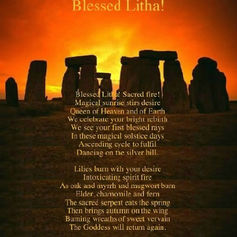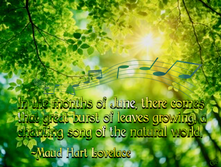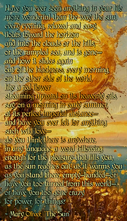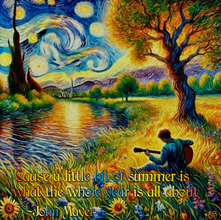
.png)









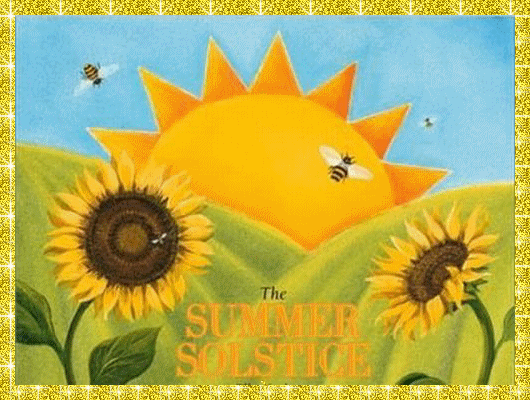
Summer's here and the time is right
For dancing in the streets



%20poster.png)
%201.png)

%202.png)
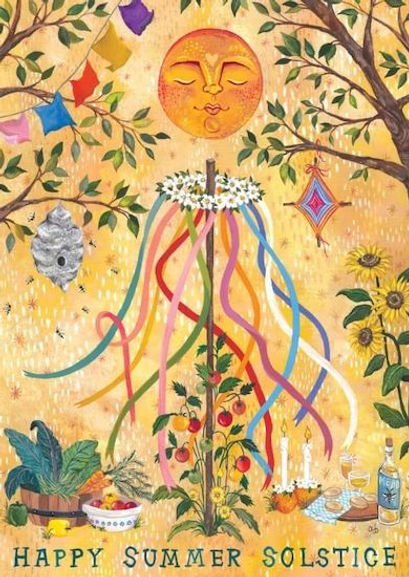
%203.png)
%20poster.png)
%20poster.png)








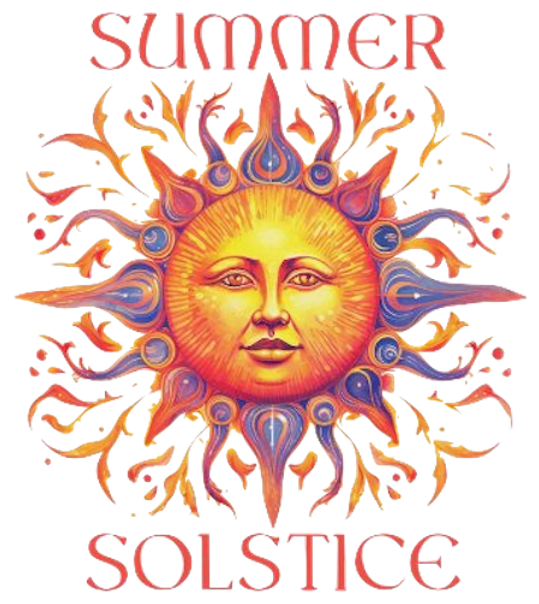




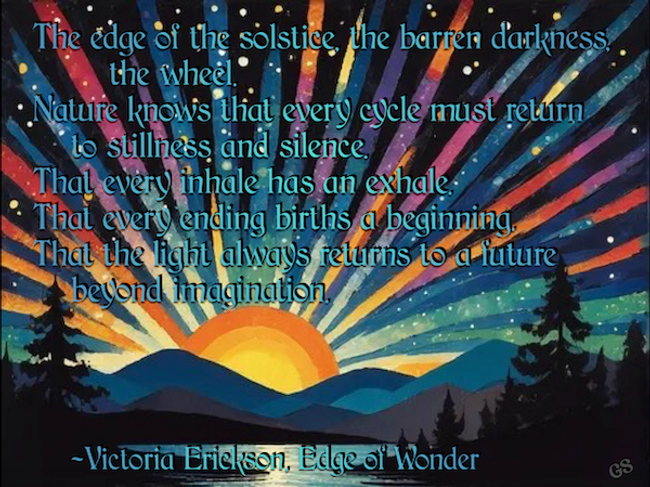








Summer Solstice and Sun Worship



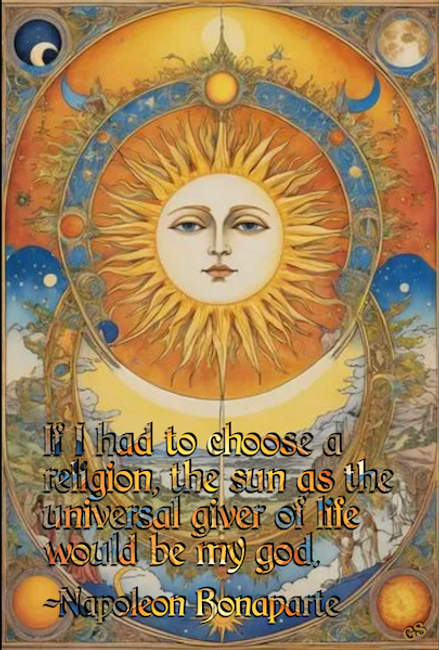



The Summer Solstice: Astronomical Dynamics

It could be said that The Summer Solstice began more than five thousand years ago, when our ancestors, who were adept at stargazing, noticed that, at certain times of the year, the sun moves from a perpendicular position over what we now know as the Tropic of Capricorn, to a perpendicular position over the Tropic of Cancer. These extreme days in the sun's position, the winter and summer solstices, coincide with December 21 and June 21, respectively, in the northern hemisphere. The day we will see the sun set furthest south is December 21, and the day we will see it set furthest north is June 21-22. Strictly speaking of the Summer Solstice, on this date the Earth's axis is tilted 23.5 degrees towards the sun, which causes June 21-22 to be the longest day of the year in the northern hemisphere.
Thematic Images For The Summer Solstice or Midsummer Solstice
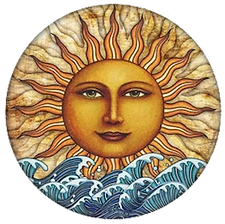







Summer Solstice/Midsummer day festival scene

Summer Solstice/Midsummer eve festival scene
The Summer Solstice is also known in Northern Europe as the Midsummer Solstice (or simply Midsummer). The name "midsummer" is attested in Old English as midsumor, and refers to the time around the summer solstice. It is an astronomical event that marks the longest day and shortest night of the year in the Northern Hemisphere. It occurs when the Earth's tilt is closest to the sun, resulting in the sun reaching its highest point in the sky. In the Northern Hemisphere, this usually happens on June 20th, 21st, or 22nd.
Midsummer is a celebration of the season of summer, taking place on or near the date of the summer solstice in the Northern Hemisphere (particularly in Scandinavian countries). The name "midsummer" mainly refers to summer solstice festivals of European origin. These cultures traditionally regard it as the middle of summer, with the season beginning on May Day.
Although, astronomically speaking, the summer solstice falls on 20, 21 or 22 June in the Northern Hemisphere, midsummer was traditionally reckoned to fall on the night of 23–24 June in much of Europe. These dates were Christianized as Saint John's Eve and Saint John's Day. Midsummer is also known as Jāņi, Enyovden, Līþa/Lithe, midsommar, Ivan Kupala Day, Juhannus/Mittumaari (from Swedish midsommar) /Keskikesä (from Swedish midsommar), Alban Hefin, Gŵyl Ganol yr Haf, Sankthans, Joninės, jaanipäev, Kresna noč.
It is usually celebrated with outdoor gatherings that include bonfires and feasting. There is evidence that the summer solstice has been culturally important since the Neolithic era, with many ancient monuments throughout Eurasia and the Americas aligned with sunrise or sunset on the summer solstice.
Summer Solstice/Midsummer Divine and Semi-Divine Figures

Summer Solstice/Midsummer goddess

Summer Solstice/Midsummer Faeries

Summer Solstice/Midsummer Figures

Summer Solstice/Midsummer Celebrations Around The World



Summer Solstice/Midsummer Bonfire Rituals Around The World

Before the festival became Christianized, the peoples of Europe lit bonfires in their fields to help the sun in a symbolic act, ensuring that it "would not lose strength." In their inner consciousness, they knew that fire destroys evil and harmful things. Therefore, they would run their livestock through the bonfires and the people would leap the flames in order to cleanse and drive away evil spirits. Later, humans would continue to destroy spells with fire, and Christianity was adept at recycling old pagan cults. In Eastern countries, with distinct rites and beliefs, these festivals were also celebrated, all maintaining the same essence: paying homage to the sun, which has a special role to play on that day, when the power of darkness has its shortest reign.
Summer Solstice/Midsummer of the Neopagans

Neopagan Wheel of the Year (Eight-spoked)

The Neopagan Wheel of the Year is an annual cycle of eight sabbats (festivals) celebrated by many Neopagan traditions, including Wicca. Originally, the Celtic Wheel of the Year was only the four "cross-quarter days" of Samhain, Imbolc, Beltane, and Lughnasadh, but the Neopagan tradition added four more; marking the year's chief solar events (solstices and equinoxes) and the midpoints between them: Samhain, Yule, Imbolc, Ostara, Beltane, Litha, Lughnasadh, and Mabon. The eight-spoked wheel of the year represents the changing seasons and the cyclical nature of life, death, and rebirth.
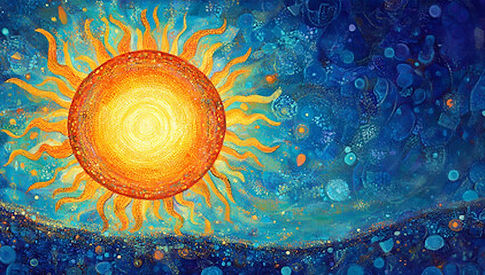





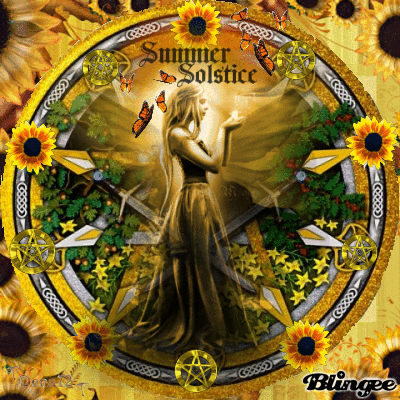





Litha Summer Solstice/Midsummer

Litha, also known as the Summer Solstice, is a pagan holiday marking the longest day of the year and the peak of summer, which was known to the Celtic Druids as "Alban-Heruin" ("The Light of Summer or The Light of the Shore"). It's one of the eight sabbats in the Wheel of the Year, celebrated by modern neopagans, such as Wiccans. Litha is a time for celebrating the sun's power, fertility, abundance, and the turning of the seasons. Litha is a significant sabbat in Wiccan and pagan traditions, marking the height of summer and the sun's power. Thus, Litha is a time to honor the sun, its life-giving energy, and the abundance of the summer season.




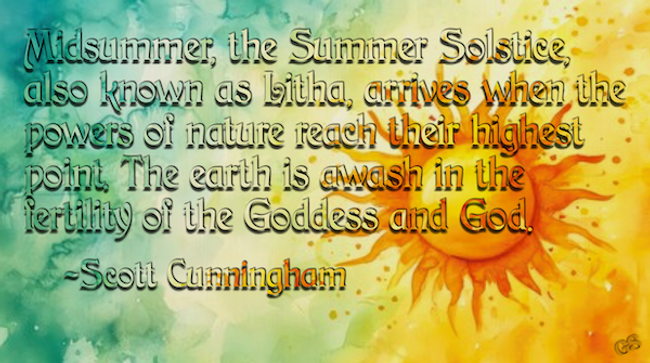
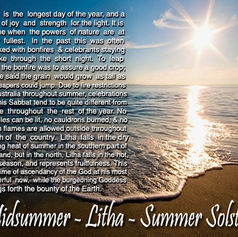












The Celtic Goddess Áine


Áine is an Irish goddess of summer, fertility, love, wealth and sovereignty. She is associated with midsummer and the sun, and is sometimes represented by a red mare. Her name itself translates to "radiance.” As the goddess of fertility, she had command over crops and animals and is also associated with agriculture. Neopagan groups honor Áine during Litha.

Litha Summer Solstice Celebrations



Litha Paganfest fire-circle





Summer Solstice/Midsummer At Stonehenge, Avebury, and Newgrange

At Midsummer the hot sun shines the longest and reaches the highest point in the sky. At the Summer Solstice, the longest day is celebrated at many megalithic stone circles and monuments, particularly Stonehenge, Avebury, and Newgrange, where Neolithic people constructed their great temple, recording and predicting celestial events and acting as a focus for seasonal gatherings.



%203.jpg)
%204.jpg)
.jpg)
%202.jpg)
Summer Solstice/Midsummer Sunrise and Sunset


Summer Solstice/Midsummer Artwork
.jpg)

Summer Solstice/Midsummer Psychedelic







Summer Solstice/Midsummer Great God Pan





.jpg)
.jpg)
Pan statue with his pipes (Nymphenburg Park, Munich, Germany)
Great God Pan (Joubert)

Great God Pan Poetry Memes








This Van Morrison song is a faithful distillation of Ch. 7 of The Wind and the Willows (1908) by Kenneth Graham, “Piper at the Gates of Dawn.” It is also the name Syd Barrett chose for the first Pink Floyd album.


Pan, Dionysus, Ariadne, Gaia, Greenman and Jimi Hendrix
"Pan In America" by D.H. Lawrence

D.H. Lawrence wrote an essay entitled "Pan In America" (1924) that recognizes the god Pan as symbolizing the heart of paganism and sexual liberation. The essay emphasizes the importance of coexisting with nature rather than conquering it. As humans have advanced technologically, our relationship with nature has changed from seeing ourselves as part of it to viewing it as something to exploit. Earlier people lived in closer proximity to nature and could develop unique psychic connections with it that helped them survive. Lawrence argues it is better to live as a hunter in nature than a clerk separated from the natural world. He envisions the needed return of Pan to our technological world as bringing back what could be called an "animistic" world view.



Summer Solstice/Midsummer Memes

%20meme.jpg)




%20meme.jpg)


%20meme.jpg)











%20meme.jpg)
%20meme.jpg)
%20meme.jpg)
%20meme.jpg)

















































































